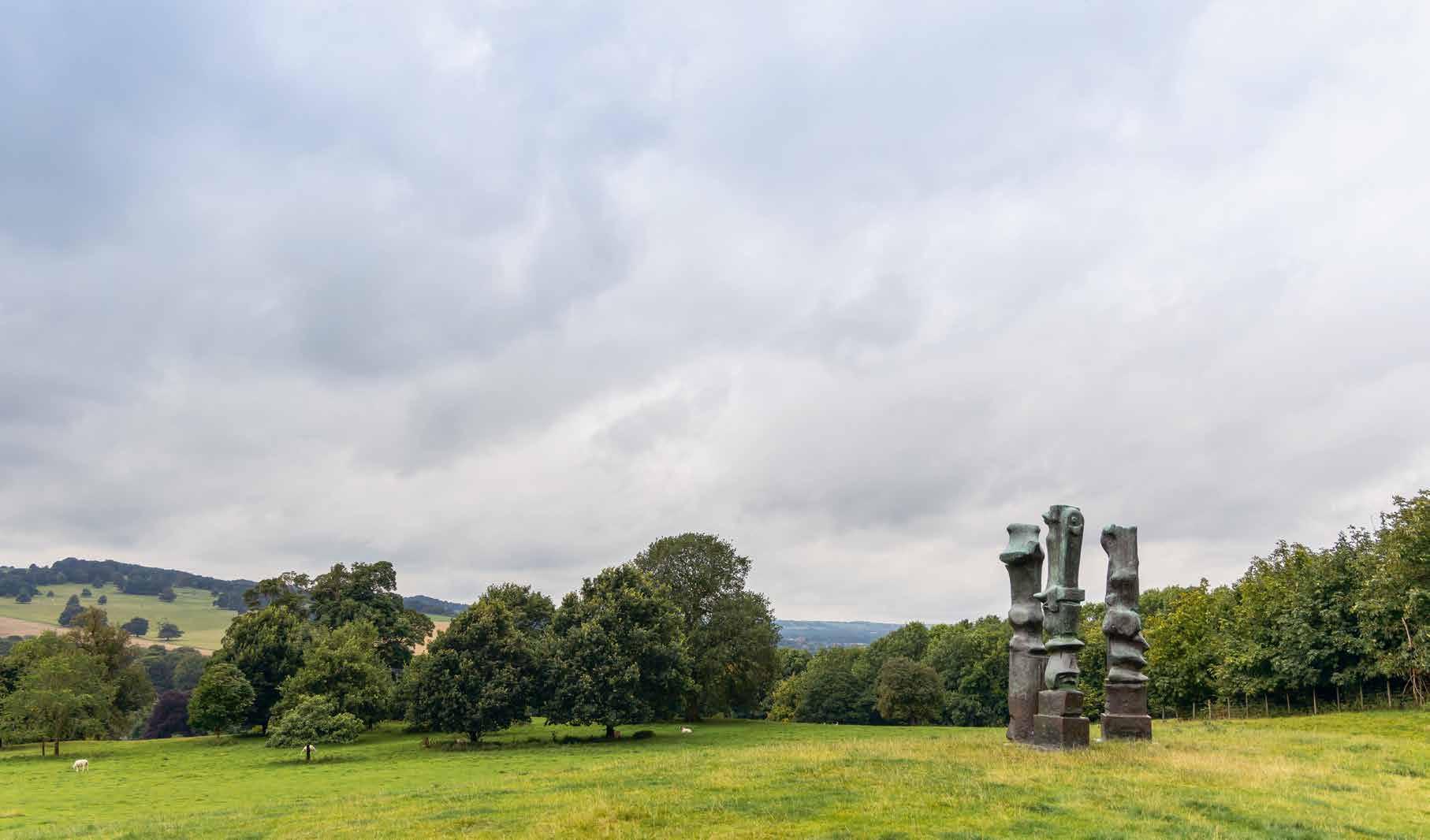

Inhoud
Voorwoord
Brigitte Bloksma
Traditie en vernieuwing: botsende tendenzen in het oeuvre van Henry Moore
Sebastiano Barassi
Over het onderzoeken en begrijpen van vorm: materiaal, werkwijze en kennisverwerving in het werk van Henry Moore
Hannah Higham
De aankoop van Henry Moore’s Warrior with Shield door de stad Arnhem
Joost Bergman
Leven en nalatenschap van Henry Moore
Emanuela Varga
Lijst

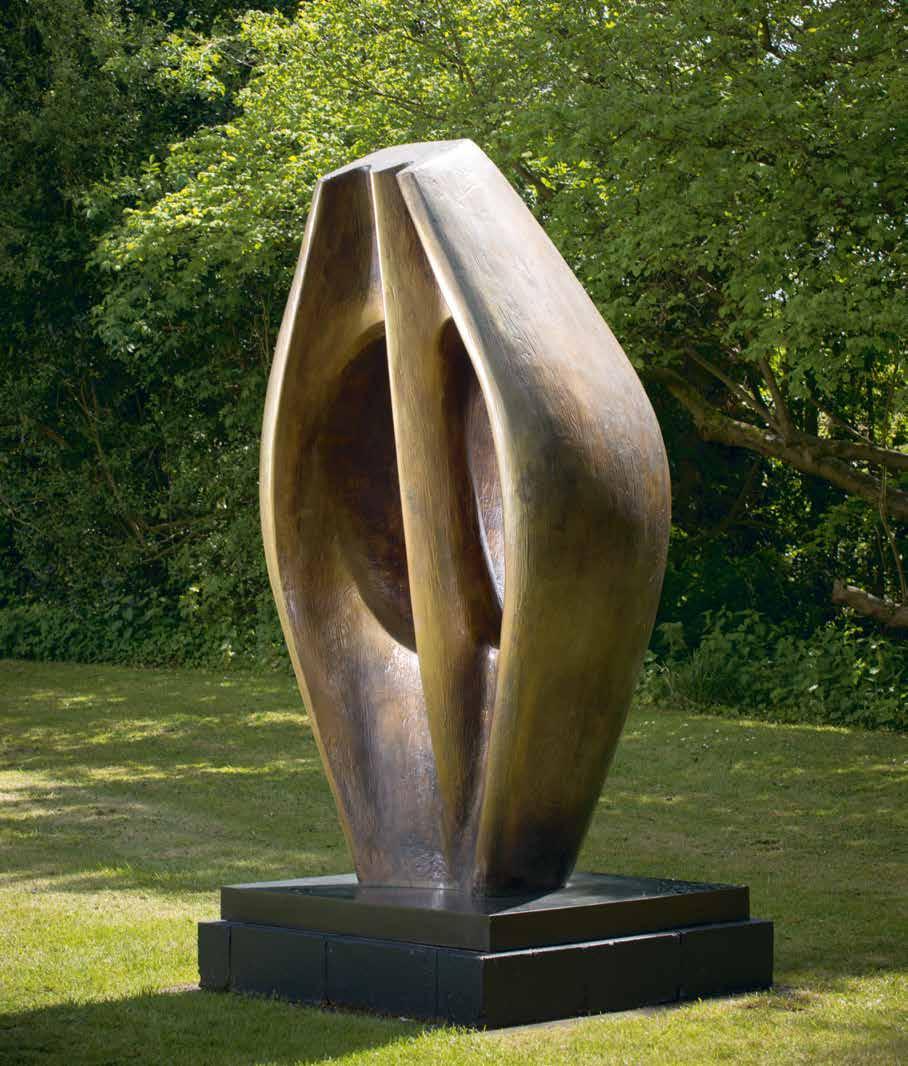
Large Totem Head, 1968, LH 577 gietsel / cast 0, brons / bronze, 246 × 133 × 122 cm
Links / left: Henry Moore bij / with Knife Edge Two Piece (1962 - 65) in Perry Green, 1965
Carving, 1936, LH 164, travertijn / travertine marble, 52 × 49,2 × 24 cm
te zien, duizelingwekkend hoge kliffen die zich in zee lijken te storten. In Moore’s verbeelding vormden die beelden metaforen voor de relatie van de mensheid met de aarde, ze verwijzen naar de rotsformaties in Adel Crag in Yorkshire, zijn geboortegrond of naar schilderijen zoals Georges Seurat maakte van de rotskust bij Étretat.
Ambivalenties, tegenstellingen zelfs, treden al in het vroegste werk van Moore aan het licht. Ze manifesteerden zich op verschillende wijzen en in verschillende perioden tijdens zijn carrière, al namen ze zelden een destructieve vorm aan. Na zijn eerste bezoek aan Italië in 1925, net afgestudeerd aan de academie, toen hij nog een jonge beeldhouwer was die de voetsporen volgde van voor-oorlogse avant-garde kunstenaars als Jacob Epstein, Constantin Brancusi, Pablo Picasso en Henri Gaudier-Brzeska, werd Moore zich bewust van het conflict tussen zijn enthousiasme voor de beeldhouwkunst buiten de klassieke traditie – de Meso-Amerikaanse, de Cycladische beeldhouwkunst, de Engelse gotiek, beelden uit Mesopotamië en zijn opbloeiende liefde voor de humanistische traditie van de beeldhouwkunst uit de veertiende en vijftiende eeuw die hij in Toscane had ontdekt. Moore beschouwde die tegenstelling als exemplarisch voor de polen waartussen hij zelf bewoog en die hij omschreef als ‘het ruwe en het tedere’, ‘het klassieke en het romantische’. Zijn doel was om een kunst te scheppen waarin geen van die begrippen de boventoon zou voeren, maar een kunst die verrassingen zou toelaten, verbeelding, organische en biomorfe(?) vormen, zacht en vol rondingen – romantisch van karakter maar in samenhang met, en versterkt door classicistische noties als orde, symmetrie, hardheid, balans en stasis (?)
In de jaren dertig was Moore een voorstander van zowel de surrealisten als abstracte stromingen als Unit One en Circle. Hoewel beide bewegingen vaak tegengestelde standpunten verdedigden weigerde Moore partij te kiezen en zocht naar een beeldtaal die elementen van de verschillende bewegingen kon samenvoegen tot een idioom dat de tegenstellingen zou overstijgen en zowel een universele aanspraak als een bredere erkenning zou vinden. In Carving uit 1936, (afb. p. 22) combineerde Moore bijvoorbeeld de griezelige eigenschappen van maskers – waarin zowel de echo van Azteekse beelden als die van de surrealistische fascinatie voor het theatrale doorklinken – met een geometrische, semi-abstracte weergave van een menselijk gezicht vanuit een onnatuurlijke hoek bezien, wat een even markant als ontroerend beeld opleverde. Zijn keuze voor een niet-beschrijvende titel lijkt te wijzen op Moore’s wens om zijn beelden niet vooraf te belasten met interpretaties, maar
Rechts / right: Carving, 1934, LH 142, Afrikaanse wonderstone / African wonderstone, 11,9 × 10,4 × 7,5 cm

materials traditionally associated with classical statuary, in particular white marble, in favour of stones more typically used in architectural decoration like travertine and Hopton Wood, or rarely used for sculpture and with an exotic feel, such as the ‘African wonderstone’ of his 1934 Carving (image p. 23). By learning to master such materials, Moore not only declared his distance from the art of the past, but was also able to imbue his sculpture with a feel of originality and innovation that more traditional stone would have lacked.
During the Second World War Moore almost completely stopped making sculpture, in part because of the difficulty of sourcing materials, and instead turned his attention to drawing. When he returned to three-dimensional work in the second half of the 1940s, his approach changed quite radically. Previously, Moore had developed new ideas for sculpture through quick preparatory sketches or more finished drawings, but after the war almost all of his sculptures started life as maquettes, small models made in plaster, clay or terracotta, which often evolved from found objects such as bones, stones and shells.
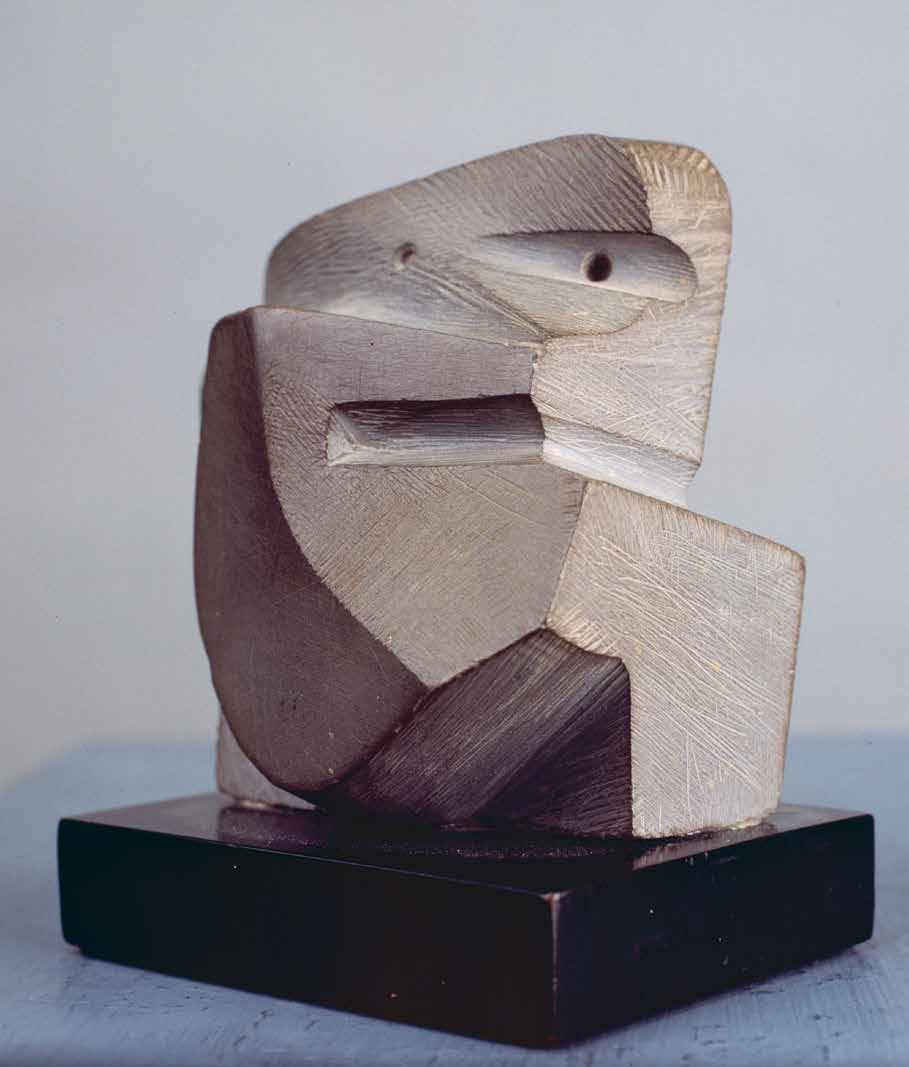

Tree Figure, 1979, LH 771 gips / plaster, gips met gekleurd oppervlak / plaster with surface colour, 18,8 × 7,5 × 6 cm
Rechts / right: Man and Woman II, 1978, LH 743 gips / plaster, gips / plaster, 23,5 × 10 × 6,5 cm
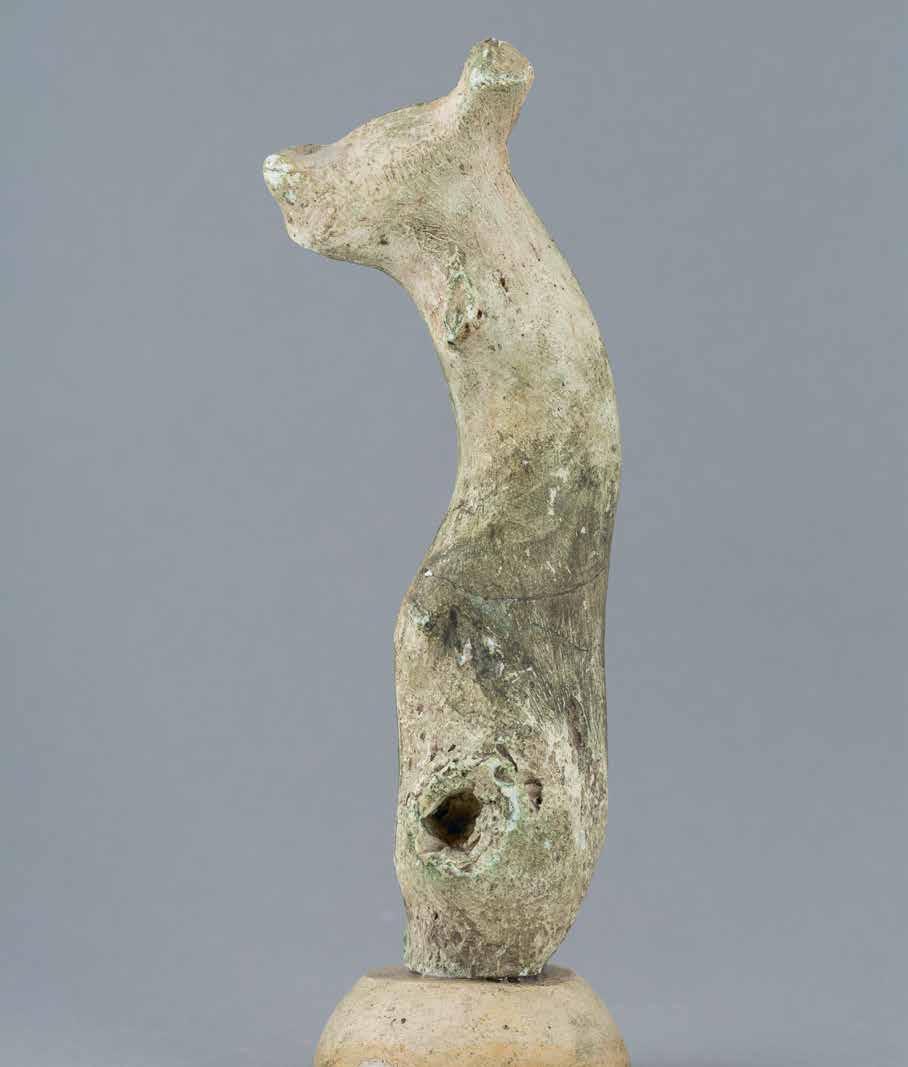
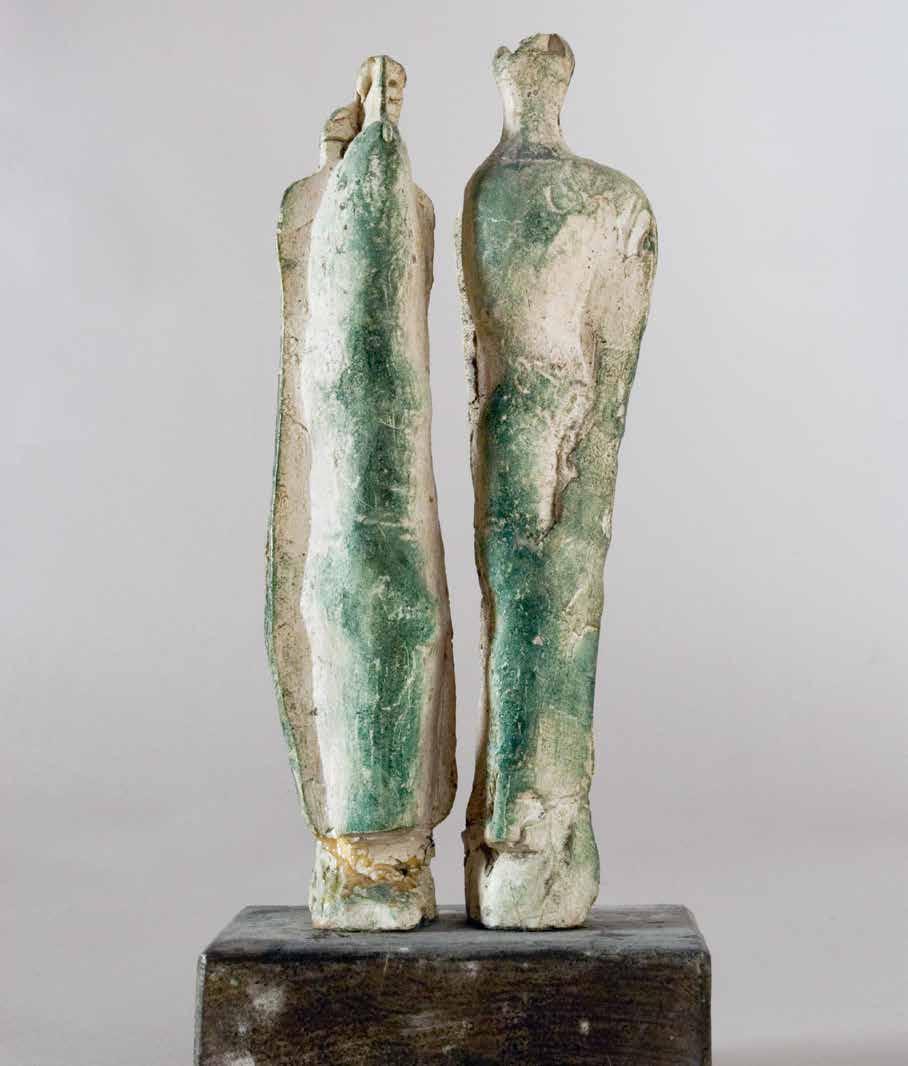


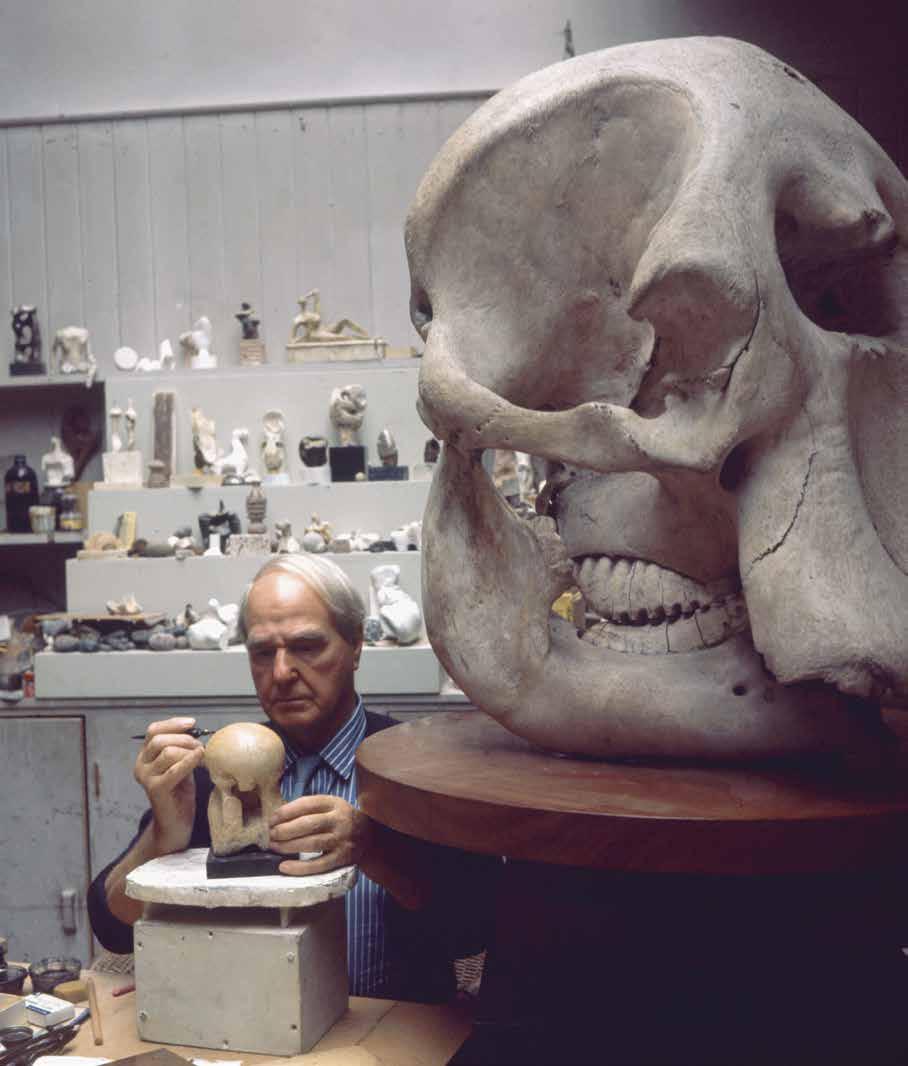

eisen aan de kunstenaar en vormt het een nieuwe koers voor de beeldhouwer. Moores begrip van de eigenschappen van lood en brons leidde tot nieuwe sculptuurideeën die, aldus Clark, ‘metaalachtige ideeën’ waren, waarbij ‘idee en materiaal al bij conceptie samenkomen’.16 Truth to material bleef het uitgangspunt, zelfs ondanks dat gieten een minder directe handeling was dan beeldhouwen.
Waarschijnlijk ging het Moore niet alleen om de plastische eigenschappen van metaal. Hij omschreef lood als een metaal met een ‘giftige eigenschap’ en was zich ervan bewust dat het minder beschikbaar zou zijn als er munitie van gemaakt moest worden.17 Ook brons was in het verleden tijdens conflicten minder beschikbaar geweest. Vanwege het omsmelten van vijandelijke kanonnen nam de politieke macht van het materiaal na een oorlog toe, evenals de connotatie van het materiaal met leven en dood. Martina Droth heeft onderzoek gedaan naar de wijze waarop het smelten van brons symbolische associaties oproept met de macht van de bronsgieter, die welhaast demiurgische krachten bezit om de materie opnieuw tot leven te wekken.18
Het gieten van metaal is een vorm van metamorfose. Dit feit alleen al legt een relatie tussen de techniek enerzijds en de natuur en creatie anderzijds. Dat Henry Moore wandelend stenen verzamelde op de stranden in Norfolk wijst niet alleen op zijn liefde voor steen, maar ook op zijn belangstelling voor de natuur in bredere zin. In de jaren twintig interesseerde hij zich al voor het verzamelen van organische objecten, zoals stenen, schelpen en botten. In de jaren dertig begon hij deze objecten systematisch te bestuderen in zijn zogenoemde Transformation Drawings. Daarnaast las hij On Growth and Form uit 1917 van de wiskundige en bioloog D’Arcy Wentworth Thompson, die de onderlinge relatie tussen groei en vorm omschrijft met behulp van wiskundige formules. Moore was waarschijnlijk vooral geïnteresseerd in zijn argumenten over hoe vorm door groei (van binnenuit) en natuurlijke krachten (van buitenaf) kon worden bepaald.19
De rijkdom van de natuurlijke verschijnselen (naast de enorme visuele variëteit ook de vormende krachten van de natuurwetten) vormden een onuitputtelijke bron van inspiratie voor Henry Moore. Hij wilde deze processen in zijn werk opnemen, omschreef botten als voorbeelden van innerlijke kracht en structuur, en als een vorm die van binnenuit kracht uitoefende.20 Moore voelde deze interne dynamiek waarschijnlijk wel intuïtief
Henry Moore werkend aan Atom Piece, midden jaren ’60 / Henry Moore working on Atom Piece, mid- 1960s
a similar history of unavailability during conflict. Indeed, post-war the melting of foreign cannon and the statues of defeated rulers enhanced the political power of the material and its connotations with life and death. The symbolic associations of bronze and the demiurgic powers of the bronze caster who could control a material capable of resurrection have been examined by Martina Droth.18
Casting metal was a process of metamorphosis. This fact in itself would link the practice with nature and with creation. Moore’s gathering of pebbles on the beaches of Norfolk is indicative not only of his interest in stone, but in the natural world more broadly. In the 1920s, Moore had already established an interest in collecting organic objects such as stones, shells and bones and by 1930, he subjected these to programmatic study in his so-called ‘Transformation Drawings’. His exploration of these forms was complimented by his reading of On Growth and Form, written by mathematical biologist D’Arcy Wentworth Thompson, which had been published in 1917. D’Arcy Thompson proposes the inter-relation of growth and
form through the application of mathematical formulae. Perhaps of particular interest to Moore were his arguments on how both (internal) growth and (external) natural forces could determine form.19
The multiplicity of natural phenomena, not only its visual variety but also the formative forces or laws of nature, were an endless source of inspiration to Moore. He wanted to adopt its principals and in particular, Moore fixed on bones as examples of inner strength and structure, of forms pressing from the inside.20 While carving had perhaps allowed Moore to intuit this sense of internal dynamism its action was glyptic – one of working from the outside in. Modelling and casting are plastic techniques, which offer very different sculptural values. One might even say that Moore’s relationship to the natural forms he amassed, and which lined the shelves of his studio, evolved from tactile to haptic. The ironstone pebble was picked up, turned over in his hand, its hard external qualities keenly felt. Later such bones and stones are similarly handled but seem to relate to the very structures of the hand – muscles gripping, the
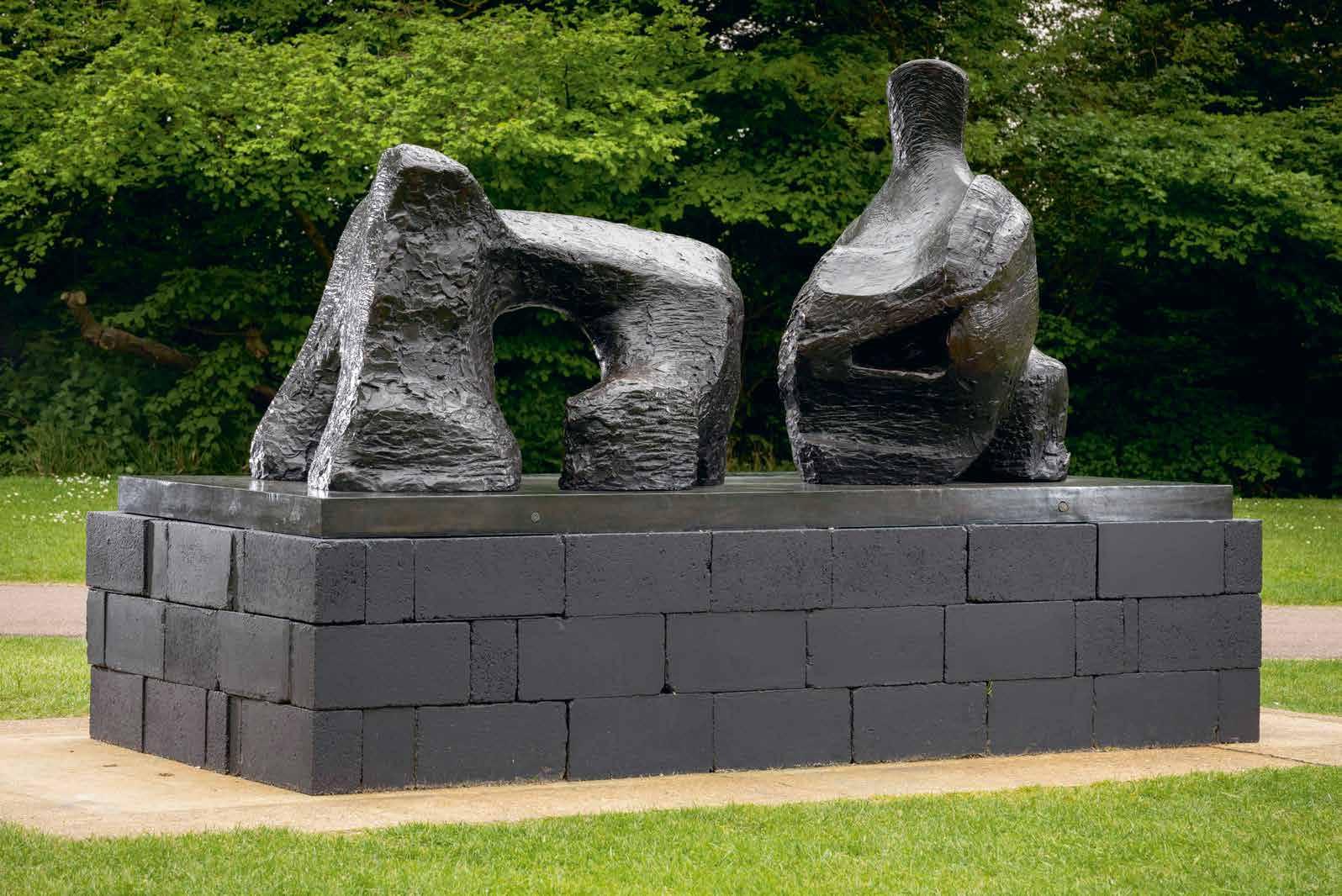

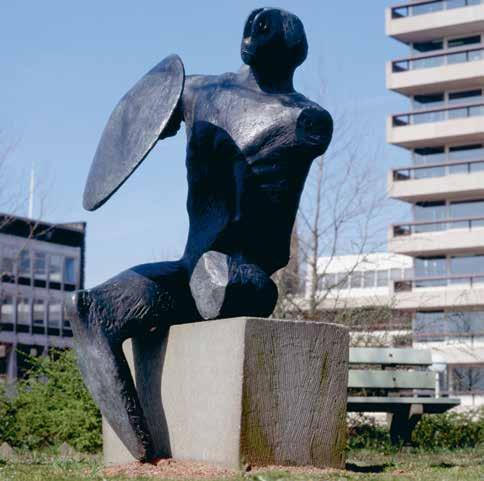
‘It is our view that the secrecy has lasted long enough, and that it is high time that there was an explanation. Or even better: let them place the sculpture where it belongs and for which it was made’.29
In the early 1960s there were once again plans to install Warrior with Shield near the Rijnbrug at last, but once again they fell through. Even the minutes of the city council do not make it clear precisely what the delay was and why the decision was constantly being postponed. For instance, Pierre Jansen, director of the Gemeentemuseum and TV presenter of arts programmes who, by way of a trial, placed it beside the Eusebius Church, which had been largely destroyed during the war.30 Then, in the late 1970s, a spot was allocated for it in Gasthuisstraat, close to the Walloon Church, where vandals tore it off its base on New Year’s Eve 1980 (fig. 10).31 That prompted the city to move the damaged sculpture once again, in the early 1980s, this time to Oranjewachtstraat, behind the Gelderland Provincial House (fig. 11). This, of all the places where it had stood, was the spot that best matched Moore’s initial choice, facing the
10. Algemeen Dagblad, 5 januari 1980
Boven / above: 11. De sculptuur opgesteld aan de Oranjewachtstraat, ca. 1985- 1989 /
The sculpture set up on Oranjewachtstraat, c. 1985- 1989
